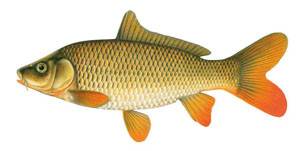 The common carp prefers large, and warm bodies of water with slow moving to standing water. But as hardy fish, they can tolerate many other conditions. Unlike trout, the common carp can survive in water with very little oxygen, and can live live through large temperature changes. Carp can usually be found living in groups called schools, however, many larger carp are known to live alone. As young fish, the carp feeds on zooplankton, and algae, and on caddisflies, snails, and crustaceans when it gets a little bit older and larger, but as they reach adulthood, the carp becomes an omnivore, eating things such as insects, crustaceans, worms, mollusks, fish eggs, fish remains, plant tubers and seeds. They feed by sucking up mud from the bottom of the water, selecting what they want to eat, and spitting out the rest. By doing this however, the carp stir up the mud which causes plants to have a hard time growing, and the stirred up mud lowers the water quality.
The common carp prefers large, and warm bodies of water with slow moving to standing water. But as hardy fish, they can tolerate many other conditions. Unlike trout, the common carp can survive in water with very little oxygen, and can live live through large temperature changes. Carp can usually be found living in groups called schools, however, many larger carp are known to live alone. As young fish, the carp feeds on zooplankton, and algae, and on caddisflies, snails, and crustaceans when it gets a little bit older and larger, but as they reach adulthood, the carp becomes an omnivore, eating things such as insects, crustaceans, worms, mollusks, fish eggs, fish remains, plant tubers and seeds. They feed by sucking up mud from the bottom of the water, selecting what they want to eat, and spitting out the rest. By doing this however, the carp stir up the mud which causes plants to have a hard time growing, and the stirred up mud lowers the water quality.
The common carp spawns around spring and early summer, when the female scatters her eggs in shallow water with many weeds. The male then fertilizes the eggs, which immediately begin to develop, and take only 3 to 4 days to hatch depending on the water temperature. Typically, an average female will lay up to 300, 000 eggs, though that varies depending on the size of the female. Females become sexually mature at 4 to 5 years, males at 3 to 5. 13 to 20 years is the average life span of the carp.
Further Reading
Click Here for information from the University of Michigan